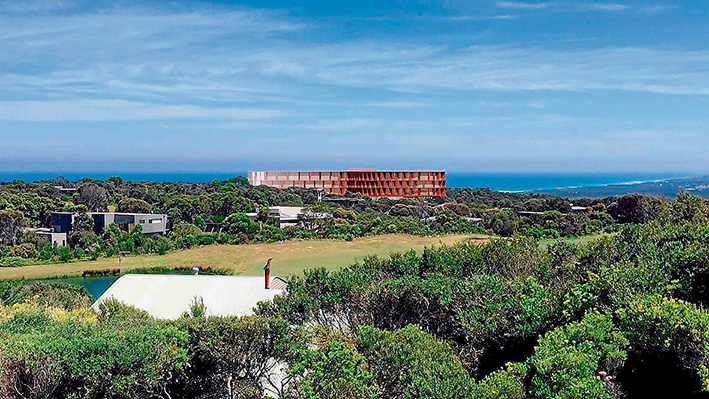THE shire council approved the controversial $135 million RACV resort expansion at Cape Schanck at its meeting on Monday night last week in front of a packed and sometimes unruly gallery dominated by resort opponents.
Just four councillors were needed to approve the development, which was first publicly proposed in mid-2013.
The council was reduced from 11 to seven councillors with three absent (Tim Wood, whose ward covers the resort, Lynn Bowden and Hugh Fraser) and one declaring a conflict of interest and leaving the council chamber, Graham Pittock (who has shares in the National Golf Club, which adjoins the RACV property).
Voting on the project had been delayed twice since May with councillors who belong to the RACV Club worried about conflict of interest. The council sought a ruling from local government minister Natalie Hutchins but she told them to get their own legal advice.
Voting for the resort were Antonella Celi, David Garnock, David Gibb and Anne Shaw. Against were the mayor Bev Colomb, Andrew Dixon and Tim Rodgers.
A report to the council from planner Arthur Cooksley stated it was “recognised that the proposed hotel/resort building is a substantial built form, presenting as a five-storey building from most aspects, with the exception of the aspect facing towards Trent Jones Drive, which presents as a seven-storey building”.
This was the main objection of opponents, many of whom live close to the proposed building. A dozen spoke at the meeting with one saying the building “sits starkly above the ground as an intrusive and dominating element” and was “entirely at odds with the design philosophies which have informed 30 years of development at the resort”.
Mr Cooksley said homes in the precinct were limited to eight metres high but this rule did not apply to the resort.
Objector Ian Renwick conducted a survey of residents and others, and said 240 had responded with 82 per cent against the proposal and 18 for.
Objector Irene Wyld, chair of Moonah Estate Owners Corporation, said she represented 70 residents in the estate, a third of the allotments in the precinct. She was concerned about the resort’s size and noise late at night.
She said the RACV had missed an opportunity to create a lower building and win support of all residents.
Debbie Withers of Friends of Cape Schanck said she represented 40 residents.
“Thirty metres is too high and is not of a colour that complements the existing landscape both natural and built form,” she said. “A lower building was suggested by the Office of the Victorian Government Architect,” Ms Withers said.
“We are also concerned about noise, light and overshadowing as well as increased traffic, all of which impact on the local amenity and will change the coastal village nature of Cape Schanck.”
Ms Withers was critical of the minimal community consultation that had occurred.
Objector Ken McNamara said if the council approved the resort, it would open the floodgates for developers to construct other large buildings on the peninsula but this was later refuted by Arthur Cooksley who said the resort precinct was covered by a special planning scheme that allowed the 30-metre resort.
“The resort will be a towering edifice that will be glaring and staring into our bedroom,” he said.
“Most in the community welcome the redevelopment for the economic benefits it will bring but do not welcome the prospect of this oversized building dominating the skyline.”
Objector John Quinn said he was speaking for residents in National Drive. “The proposed seven-level building will be more than 10 metres above the adjacent ridge line and be visible from Portsea.”
RACV Cape Schanck manager Conleth Roche said the RACV had 54,000 members on the peninsula.
He said the club had been working with the shire and “local community” since 2008 when a master plan was produced.
“The region badly needs employment and our project will attract more conferences to the peninsula,” he said.
Mr Roche said the building had been sited between two ridges, had two floors underground, indoor loading bays and was 10 per cent slimmer than first proposed, eliciting groans from the gallery and a warning from meeting chair Bev Colomb.
He said the RACV would not be applying for an extra floor, as some objectors had feared after this occurred at RACV’s Torquay resort.
He said it was unlikely that the resort would have 650 people on site at once, which is permitted under the planning document approved by former planning minister Matthew Guy last year.
Mr Roche said the resort’s night manager and security would suppress excessive noise from customers.
Mr Cooksley said the resort would create 476 full-time jobs during construction, with up to 120 full-time jobs after completion. “It will provide an annual economic impact of $11.7 million and support an additional 93 jobs in the shire.”
Tracey Cooper, chair of the peninsula’s tourism board, said the resort would enable tourism on the peninsula to grow during the off season, a rare opportunity.
Late last week, Nepean MP Martin Dixon said the resort was “a visionary project that will frame our local economy, tourism and jobs market for the next 50 years”.
“While I am sympathetic to residents’ concerns that were raised with my office over recent months, the reality is that the proposal has been deemed by councillors, independent architects and council officers to satisfy the conditions and requirements of the planning scheme,” he said.
“I hope all councillors and ratepayers will unite behind the project and rebuild the reputation of the Mornington Peninsula as a safe and stable investment location. We need external investment to help build a sustainable local economy that is able to provide for our needs now and well into the future.”
First published in the Southern Peninsula News – 21 July 2015




